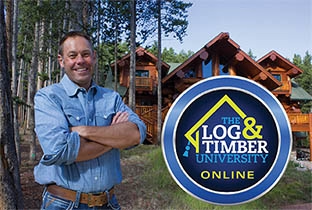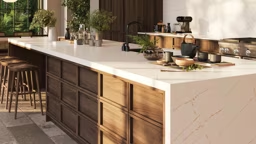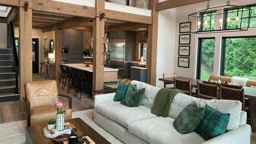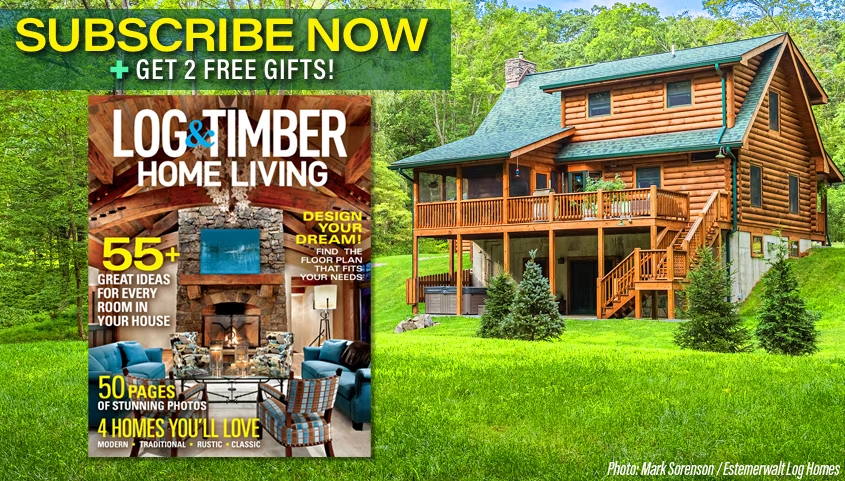
For many, the first memory of a log or timber structure comes not from home but from a journey — perhaps a lakeside cabin, a rustic lodge or a visitor center that felt as though it had sprung from the earth itself. These venerable buildings belong to the design movement known as “National Park Service (NPS) Rustic,” or, more colloquially, “parkitecture,” which originated in the early 20th century as architects sought to create structures harmonizing with the awe-inspiring landscapes of America’s national parks.
This architectural style embraces regional materials such as logs and stone to highlight the natural beauty of each location. Visionary architects like Mary Colter and Gilbert Stanley Underwood created iconic landmarks, including the Old Faithful Inn in Yellowstone.
During the Great Depression, the Civilian Conservation Corps expanded parkitecture’s influence across the country with projects featuring monumental timbers, intricate stonework and handcrafted details. These structures became lasting symbols of timeless craftsmanship and man’s connection to nature. Many of these structures not only remain standing, but are still in use. You’ll recognize them largely by their abundant natural materials but also their architectural features, including deep overhangs, staggered rooflines and prominent gables.
Parkitecture Today: The Log & Timber Way
Incorporating parkitecture begins with honoring the surrounding landscape. Thoughtful site selection ensures the structure complements its environs, while materials — locally sourced whenever possible — create a sense of harmony with the land. Features like grand stone fireplaces, heavy-timber ceilings and expansive porches invite the outdoors in, celebrating the seamless blend of architecture and the natural world.
With their massive beams, exposed trusses and warm wood textures, log and timber homes echo the same craftsmanship and attention to detail found in the classic lodges, firetowers, shelters and ranger stations that inspired generations of visitors.
Modern manufacturing techniques have elevated the style’s accessibility and versatility. Kiln drying and advanced, precision milling allow for a variety of log profiles, sizes and finishes, enabling homeowners to replicate the parkitecture aesthetic or design something entirely original. Whether it’s for a cozy cabin or a majestic lodge, today’s log and timber home manufacturers can blend tradition with innovation to meet a wide range of tastes and functions.
Honoring Tradition, Inspiring the Future
While many homeowners aspire to bring parkitecture concepts into their residences, its applications extend far beyond. Its versatility makes it ideal for commercial log and timber projects like lodges, restaurants, retail spaces and recreational facilities. The same design ethos that welcomes visitors into a national park can create spaces for gathering and hospitality in private and public venues alike.
More than a mere aesthetic, parkitecture is an enduring philosophy that honors nature and the artistry of those who work with it as their medium. With every log and timber beam, parkitecture tells a story of craftsmanship and the eternal connection between people and the land — maybe more than words ever could. As Theodore Roosevelt observed, “There are no words that can tell the hidden spirit of the wilderness, that can reveal its mystery, its melancholy and its charm.”
American Time Capsules
Theodore Roosevelt, often referred to as the “conservation president,” played a pivotal role in shaping the National Park Service. He championed the preservation of America’s natural treasures, signing legislation to establish the first five of the 63 national parks and creating the first 18 of what has grown to more than 100 national monuments under the Antiquities Act. As railroads spread westward, bringing with them adventurous recreationists, the need for lodges and public infrastructure arose, giving rise to National Park Service (NPS) Rustic.











